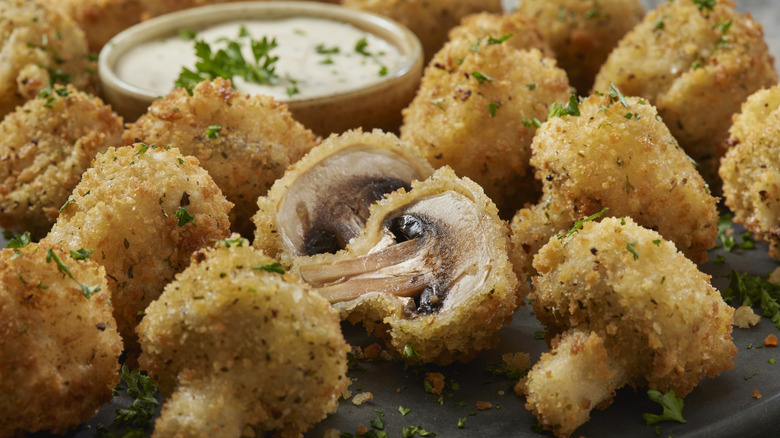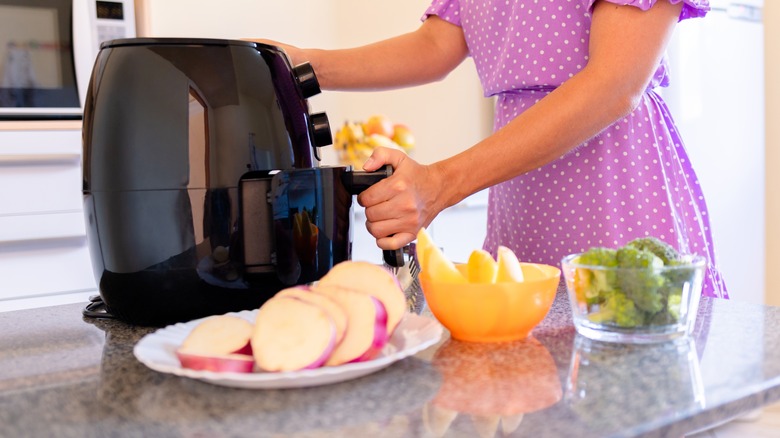The Secret To Unbelievably Crispy Air-Fried Veggies Lies In A Wet Dredge
To the uninitiated, an air fryer is just an oversized toaster oven, but that conclusion couldn't be further from the truth. In reality, an air fryer is like a convection oven, toaster, and microwave all wrapped into one compact tabletop appliance. Through the quick and continuous circulation of hot air, all surfaces of the food get crunchy — fast. No pan of hot oil is necessary.
An air fryer can make just about any food crispy — even vegetables. A flat layer of potato slices or zucchini fries can cook to browned perfection in 10 to 15 minutes. However, these are just basic variations of vegetable cookery. You can use the air fryer to take your cauliflower and asparagus to a soaring new stratosphere of flavor. The secret? A well-formulated wet dredge! A good breading, or a wet dredge, will dress your veggies in a thin coat of oil and flour, resulting in a brilliant crunch and moist, flavorful center. The best part is that you can use this breading technique on dozens of different quick-cooking vegetables.
Creating a wet dredge for crunchy air-fried veggies
When making crispy vegetables in the air-fryer, you'll want a dredge that works quickly and clings to whatever ingredient you're dipping, while also providing sufficient browning and crunch. However, the first step in the process is prepping your vegetables. For a wet dredge, you'll want to keep your vegetables as dry as possible before dipping, which will help the batter stick throughout the cooking process.
Now on to creating the wet dredge itself. There are tons of different recipes swirling around online, using everything from eggs, breadcrumbs, and baking soda to tempura beer batters. But for air-fried vegetables, a blend of cornstarch, all-purpose flour, water, and oil works well, resulting in a thick batter that really adheres to the vegetables and gives that perfect crunch. The science here is that, when mixed with flour, cornstarch slows down the development of gluten, which results in a lower moisture content and pleasantly brittle coating.
Ingredient ratios depend on the quantity of vegetables being cooked, but you'll want to stick with a 1:1 ratio of cornstarch to all-purpose flour and about a third of that in oil. For reference, a full head of cauliflower needs about ⅔ cup of flour, ⅔ cup of cornstarch, ¾ cup of water, and ¼ cup of oil, the latter of which helps give your freshly air-fried vegetables a uniform, golden color.
Which vegetables are best suited for the air fryer?
You have a lot of options when it comes to dredging and air-frying vegetables. That being said, there are two factors to consider when selecting veggies: surface area and cook time. For example, string beans cook relatively quickly and also have lots of exposed surface area that can be fully submerged in a wet dredge, as opposed to whole Brussels sprouts or a big chunk of cauliflower. Cutting zucchini, eggplant, or even hearts of palm into thick matchsticks is one way to ensure more of the vegetables get enrobed in the coating.
You'll also want to stay away from big, dense vegetables, like tubers or roots, because these tend to have longer cooking times, which increases the risk of the batter starting to burn. You can avoid this by cutting these ingredients into smaller, more manageable shapes. When it comes to quick-cooking veggies, you can use everything from okra to green tomatoes to pickles to artichoke hearts. And if you're up for it, you can even batter and fry scallions, pickles, or even olives. That's the beauty of the wet dredge; it really does make everything taste better, providing that perfect, satisfactory crunch.


